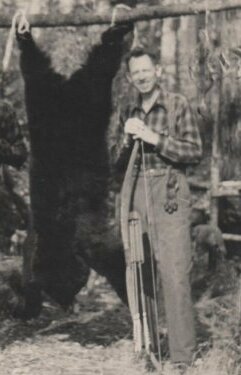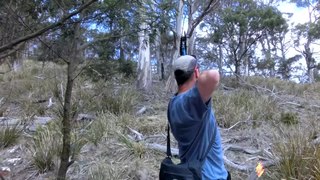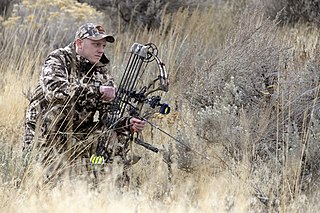
Archery is the sport, practice, or skill of using a bow to shoot arrows. The word comes from the Latin arcus, meaning bow. Historically, archery has been used for hunting and combat. In modern times, it is mainly a competitive sport and recreational activity. A person who practices archery is typically called an archer, bowman, or toxophilite.

An arrow is a fin-stabilized projectile launched by a bow. A typical arrow usually consists of a long, stiff, straight shaft with a weighty arrowhead attached to the front end, multiple fin-like stabilizers called fletchings mounted near the rear, and a slot at the rear end called a nock for engaging the bowstring. A container or bag carrying additional arrows for convenient reloading is called a quiver.

Game or quarry is any wild animal hunted for animal products, for recreation ("sporting"), or for trophies. The species of animals hunted as game varies in different parts of the world and by different local jurisdictions, though most are terrestrial mammals and birds. Fish caught non-commercially are also referred to as game fish.

An arrowhead or point is the usually sharpened and hardened tip of an arrow, which contributes a majority of the projectile mass and is responsible for impacting and penetrating a target, as well as to fulfill some special purposes such as signaling. '

Bowfishing is a fishing technique that uses specialized archery equipment to impale and retrieve fish. A bowfisher will use a bow or crossbow to shoot fish through the water surface with a barbed arrow tethered to a line, and then manually retrieve the line and arrow back, in modern times usually with a reel mounted on the bow. Unlike other popular forms of fishing where baiting and exploiting the fish's instinctual behaviors are important, bowfishing is similar to spearfishing and relies purely on the fisherman's own visual perception and marksmanship, and usually do not involve using other tools such as hand net.

Fred Bear was an American bow hunter and manufacturer. Although he did not start bow hunting until he was 29 and did not master the skill for many years, he is widely regarded as a pioneer in the bow hunting community. Bear was a world traveler, film producer, and the founder of Bear Archery. He died in Gainesville, Florida and is inducted in the Bowhunters Hall of Fame.

Big-game hunting is the hunting of large game animals for trophies, taxidermy, meat, and commercially valuable animal by-products. The term is often associated with the hunting of Africa's "Big Five" games, and Indian rhinoceros and Bengal tigers on the Indian subcontinent.

Howard Hill was an expert bowman who for over two decades, from the early 1930s into the 1950s, was often introduced or billed as "The World's Greatest Archer". He established the record for winning the most bow-and-arrow field tournaments in succession, a total of 196 competitions. In addition, Hill served as a supporting actor, trick-shot performer, and technical adviser on archery for Hollywood shorts and feature films. He also produced and directed documentaries and instructional films on bowhunting, and in the 1950s published two books on the subject, Hunting the Hard Way and Wild Adventure.

Deer hunting is hunting for deer for meat and sport, an activity which dates back tens of thousands of years. Venison, the name for deer meat, is a nutritious and natural food source of animal protein that can be obtained through deer hunting. There are many different types of deer around the world that are hunted for their meat. For sport, often hunters try to kill deer with the largest and most antlers to score them using inches. There are two different categories of antlers. They are typical and nontypical. They measure tine length, beam length, and beam mass by each tine. They will add all these measurements up to get a score. This score is the score without deductions. Deductions occur when the opposite tine is not the same length as it is opposite. That score is the deducted score.

Field archery is any archery discipline that involves shooting at outdoor targets of varying and often unmarked distance, typically in woodland and rough terrain.
The crossbow often has a complicated legal status due to its potential use for lethal purposes, and its similarities with both firearms and other archery weapons. The crossbow is, for legal purposes, often categorized as a firearm by various legal jurisdictions, despite the fact that no combustion is required to propel the projectile.

Saxton Temple Pope was an American doctor, teacher, author and outdoorsman. He is most famous as the father of modern bow hunting, and for his close relationship with Ishi, the last member of the Yahi tribe and the last known American Indian to be raised largely isolated from Western culture.

The Archery Trade Association (ATA), is the trade group representing manufacturers, retailers, distributors, sales representatives and others working in the archery and bowhunting industry. The ATA has served its members since 1953. It is dedicated to making the industry profitable by decreasing business overhead, reducing taxes and government regulation, and increasing participation in archery and bowhunting.
This is a list of archery terms, including both the equipment and the practice. A brief description for each word or phrase is also included.

Corey Schell is an American professional bowhunter and archer. He received national exposure from Kicking Bear One-on-One as well as being on National pro-staffs for Bowtech Archery (former), HOYT (former), HHA Sports (former), Easton Archery, SKB Cases, Spot-Hogg, Athens Archery, Alpen Optics, Flex Fletch, Pine Ridge Archery, Advanced Treestand Technologies, Under Armour, Schmidty's Specialty Strings, HUK Fishing, NOMAD and Firenock. He is also the CEO of Unscripted Outdoors which produces the web based show Hunt Nasty TV and has appeared on the TV show Midwest Whitetail.
Abe Walsh is an American author who has written extensively about his hunting, fishing and back-country adventures. He has written for over 25 magazine titles, and authored or ghost-written several hardcover books on the subject. He has also appeared on-camera on television hunting shows.

A professional hunter is a person who hunts and/or manages game by profession. Some professional hunters work in the private sector or for government agencies and manage species that are considered overabundant, others are self-employed and make a living by selling hides and meat, while still others guide clients on big-game hunts.
Modern competitive archery involves shooting arrows at a target for accuracy and precision from a set distance or distances. This is the most popular form of competitive archery worldwide and is called target archery. A form particularly popular in Europe, North America, and South America is field archery, shot at targets generally set at various distances in a wooded setting. There are also several other lesser-known and historical forms, as well as archery novelty games.

Cecil was a male African lion who lived primarily in the Hwange National Park in Matabeleland North, Zimbabwe. He was being studied and tracked by a research team of the University of Oxford as part of a long-term study.
Fair chase is a term used by hunters to describe an ethical approach to hunting big game animals. North America's oldest wildlife conservation group, the Boone and Crockett Club, defines "fair chase" as requiring the targeted game animal to be wild and free-ranging. "Wild" refers to an animal that is naturally bred and lives freely in nature. "Free-ranging" means an animal that is not restrained by traps or artificial barriers, so it has a fair chance of successfully escaping from the hunt.



















